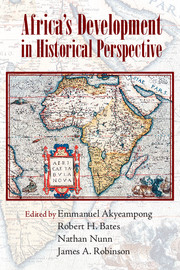Book contents
- Frontmatter
- Contents
- Author Biographies
- Acknowledgments
- Introduction
- Part I La Longue Durée
- Part II Culture, Entrepreneurship, and Development
- Part III Institutions
- 12 The Fragile Revolution: Rethinking War and Development in Africa’s Violent Nineteenth Century
- 13 The Imperial Peace
- Part IV External Forces
- Index
- References
12 - The Fragile Revolution: Rethinking War and Development in Africa’s Violent Nineteenth Century
Published online by Cambridge University Press: 05 September 2014
- Frontmatter
- Contents
- Author Biographies
- Acknowledgments
- Introduction
- Part I La Longue Durée
- Part II Culture, Entrepreneurship, and Development
- Part III Institutions
- 12 The Fragile Revolution: Rethinking War and Development in Africa’s Violent Nineteenth Century
- 13 The Imperial Peace
- Part IV External Forces
- Index
- References
Summary
Introduction
The central concern of this chapter is sub-Saharan Africa’s nineteenth century, and its place in the continent’s long-term development. I argue that although war had long been both a driver and a product of innovation and consolidation in African history, the nineteenth century is of particular importance because it witnessed a major transformation in the organization and deployment of violence. Much of the new warfare involved imported technology, expanded strategic horizons, new tactical formations, and new forms of organization, with significant political and economic implications. This was tantamount to a revolution in military affairs, which also had political and economic facets. It was, in sum, a golden age of extraordinary vitality and creativity, as well as a markedly violent one. Scholars have increasingly neglected this period, however, placing ever greater emphasis on modern conflict at the expense of deeper understanding of the role and impact of warfare in Africa’s past. Popular notions endure surrounding Africa’s violent savagery in some imagined precolonial past, and have prevented a reconsideration of the role of war in African development over the long term, as well as of the links between past and present conflict. This chapter aims to make a contribution to that debate. I suggest that in the course of the nineteenth century – in different places at different times, and for a variety of reasons – there were indications that this transformation in military affairs was moving in the direction of new and enlarged forms of political cohesion, increased economic capacity and diversification, and heightened levels of social mobility. In other words, the revolution in violence involved development, according to the most basic definition of the term.
However, this developmental process did not go far enough, especially politically – political reform usually lagged behind military advances – while economic systems remained fragile and vulnerable to both endogenous and exogenous pressures. In part, this must be seen in the context of certain perennial limitations – notably, environmental and economic challenges and uneven demographic spread – on the scope and scale of revolutionary warfare in Africa that slowed the rate of change, and indeed prevented wholesale internal reform in some cases. Ultimately, European imperial incursions – facilitated in large part, ironically, by Africa’s own violent transformation in the course of the preceding century – engendered further instability, and sharpened, indeed institutionalized, internal conflict.
- Type
- Chapter
- Information
- Africa's Development in Historical Perspective , pp. 393 - 423Publisher: Cambridge University PressPrint publication year: 2014
References
- 10
- Cited by



